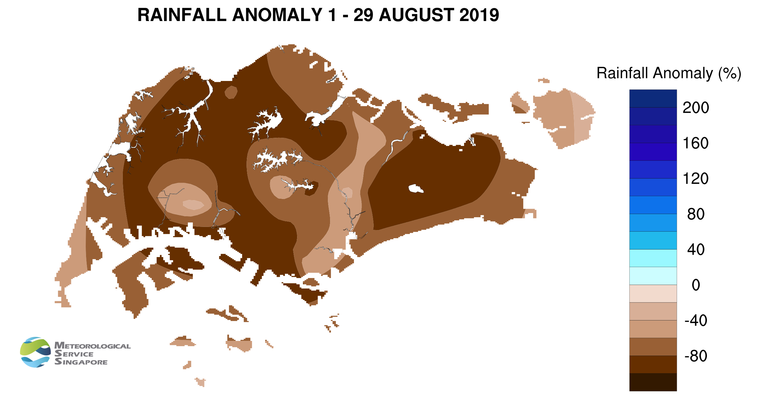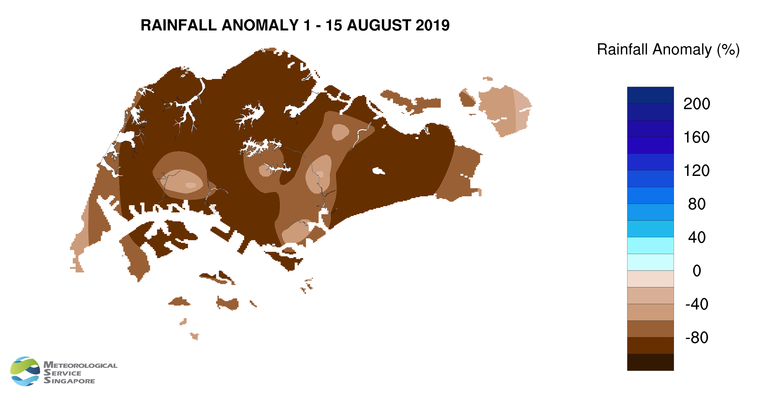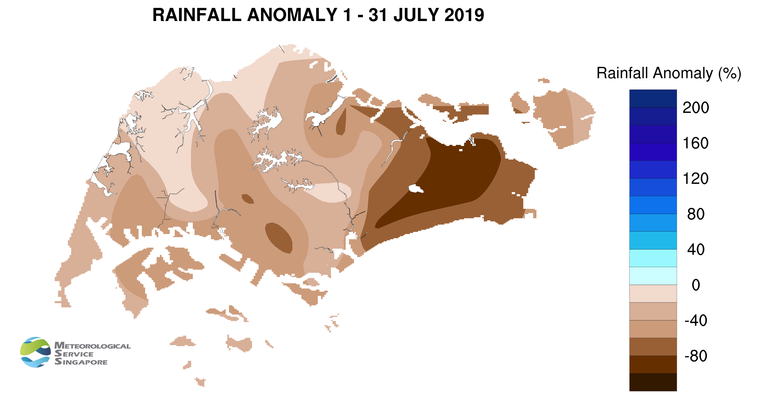August 2019 likely the driest and warmest August on record
Fortnightly Weather Outlook for 30 August – 15 September 2019
Singapore, 30 August 2019 – The prevailing Southwest Monsoon conditions in the region are forecast to persist in the first fortnight of September 2019. During the period, the low level winds are forecast to blow mostly from the southeast or southwest, and may on brief occasions, shift to blow from the west.
2 During the fortnight, the monsoon rain band is forecast to remain over the northern Southeast Asia region, away from Singapore. Under the influence of cooler sea surface temperatures over the tropical eastern Indian Ocean, dry weather is forecast to prevail over Singapore and the surrounding region in the first fortnight of September 2019. However, localised short-duration thundery showers can still be expected on four or five days between the late morning and early afternoon. In addition, Sumatra squalls are forecast to bring thundery showers and gusty winds on one or two mornings. The rainfall in the first fortnight of September is likely to be significantly below normal.
3 The first fortnight of September 2019 is expected to be as warm as the last month. On most days, the daily temperature is forecast to range between 26°C and 34°C, with highs of around 35°C on a few days. Warm nights with daily minimum temperatures above 26°C are expected on some days, reaching around 28°C in the southern and eastern coastal areas when prevailing winds blowing from the southeast bring in warm and humid air from the surrounding seas.
4 The weather in the surrounding region is also forecast to be dry in the coming weeks. Hotspots with smoke plumes continue to be observed in parts of Sumatra and Kalimantan. Depending on the direction of the prevailing winds and the proximity and extent of the fires, Singapore may experience occasional haze.
5 For updates of the daily weather and haze situation, please visit the MSS website (https://www.weather.gov.sg), NEA website (www.nea.gov.sg), or download the myENV app, MSS’ Weather@SG app, and the haze microsite (www.haze.gov.sg).
REVIEW (1 – 29 August 2019)
6 In August 2019, Southwest Monsoon conditions continued to persist with the low level winds blowing from the southeast or southwest.
7 The weather over Singapore and the surrounding region has been dry since late July 2019. Between 31 July and 16 August 2019, Singapore experienced a dry spell[1] of 17 consecutive days. The dry spell eased on 17 August 2019 when showers fell over many parts of the island that day. The highest rainfall recorded on 17 August 2019 was 13.0 mm around the city area. The extended dry weather can be attributed to an intrusion of dry air from high pressure systems over northern Australia coupled with suppressed raincloud formation due to cooler sea surface temperatures over the tropical eastern Indian Ocean (positive phase of Indian Ocean Dipole (IOD)[2]).
8 For the rest of August 2019, it was dry and warm on most days with a few days of thundery showers which brought some welcome relief from the hot and humid conditions. On 26 August 2019, strong solar heating of land areas coupled with large-scale wind convergence brought widespread moderate to heavy thundery showers over many parts of the island. The highest daily total rainfall recorded that day was 78.4 mm at Yishun. At the climate station in Changi, the total rainfall recorded for August 2019 was 11.8 mm (as of 29 August 2019), lower than the August record low rainfall of 18.0 mm in 1888. August 2019 is thus on track to be the driest August in Singapore since rainfall records began in 1869.
9 August 2019 was also a warm month, with daily maximum temperatures reaching at least 34°C on 13 days (as at 29 August 2019). The highest temperature of 34.8°C was recorded at Marina Barrage on 23 August 2019. The nights were generally warm with daily minimum temperatures above 26°C recorded over most parts of Singapore. There were a few nights in the southern and eastern coastal areas of the island where the minimum temperature was around 28°C.
10 At the climate station in Changi, the mean monthly temperature for the month is 29.1°C (as at 29 August 2019). This is 0.2°C above the highest ever mean monthly temperature for August, recorded in 2016. August 2019 is thus likely to be the warmest ever August in Singapore since temperature records started in 1929. For the month to date, the average minimum temperature for August 2019 was 27.1°C, 0.9°C above the August record high temperature of 26.2°C in 2016.
11 Significantly well-below-average rainfall was recorded across the island in August 2019. The lowest anomaly of 98% below-average was recorded at Paya Lebar.
[1] A dry spell is defined as a period of at least 15 consecutive days with daily total rainfall of less than 1.0 mm, averaged over rainfall stations with long-term records across the island.
[2] The Indian Ocean Dipole (IOD) refers to the sustained change to the difference between sea surface temperatures (SSTs) of the tropical western and eastern Indian Ocean. The IOD varies between three phases – positive, negative and neutral. A positive (negative) phase occurs when cooler (warmer) SSTs develop in the eastern Indian Ocean, resulting in below (above) normal rainfall in the eastern Indian Ocean and the surrounding region. More information on the IOD can be found at https://www.weather.gov.sg/LEARN_climate/.
CLIMATE STATION STATISTICS
Long-term Statistics for September
(Climatological reference period: 1981 – 2010)
| Average daily maximum temperature | 31.4 °C |
| Average daily minimum temperature | 24.8 °C |
| Average monthly temperature | 27.6 °C |
| Average rainfall | 156.5 mm |
| Average number of rain days | 13 |
Historical Extremes for September
(Rainfall since 1869 and temperature since 1929)
| Highest monthly mean daily maximum temperature: | 32.2 °C (1997) |
| Lowest monthly mean daily minimum temperature: | 22.4 °C (1930) |
| Highest monthly rainfall ever recorded: | 440.4 mm (1988) |
| Lowest monthly rainfall ever recorded: | 23.7 mm (1994) |


